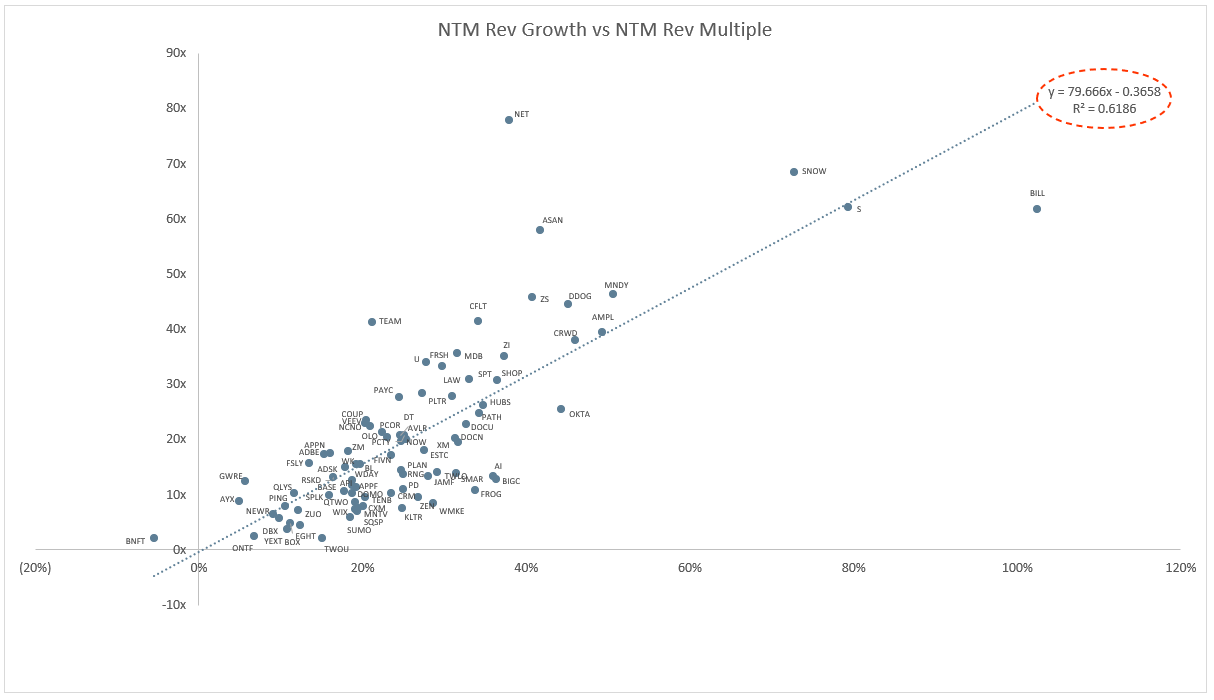Clouded Judgement 10.29.21
Every week I’ll provide updates on the latest trends in cloud software companies. Follow along to stay up to date!
Growth Durability
I posted a twitter thread this week about a theme I’ve very excited about in cloud software companies - they’re growing at much higher rates for longer periods of time than anyone imagined.
Historically, many people have overestimated how quickly software companies would decelerate growth. below chart shows rough Datadog quarterly growth expectations at IPO (orange) and actual (blue)
Datadog has grown much faster (by a wide margin) than they were expected to at IPO The biggest effect of this? Compounding $$ growth At IPO (Sept '19) Datadog was projected to do ~$610M of revenue in 2021. Current projections? $1.3B! In just 2 years expectations have doubled.
For best in class cloud software businesses we're seeing growth rates prove extremely durable. Markets are much larger than expected, and high net retention rates (growth from existing customer base) is propping up overall growth rates. If you knew Datadog would "outperform" expectations so wildly back in Sept '19, it's fair to say the stock would have looked extremely "cheap" back then. I think public markets are starting to price this in. One can definitely argue we've gone too far :)
Crowdstrike is another example below. At the time of their IPO (June '19) they were projected to do $756M of revenue in 2021. Current estimate? $1.4B. Just staggering overperformance in 2 short years.
The broader market is appreciating what best in class software businesses are capable of. People EXPECT growth to be more durable in the future. Multiples have expanded However this rising tide (plus many other factors like low rates ) have propped up the entire industry. Not all software companies are best in class. By definition there are only a few who deserve to be in that category And I try and stay sober - software multiples are way too high and due for a contraction to historical averages. It doesn't feel sustainable at all currently. When multiples contract (which I believe they will), many average software companies will get thrown out with the bathwater But what happens to the elite? Will they get the (relative) same treatment?
Multiples should come down across the board. But will they fall as hard for the best in class businesses, when there's now a broader appreciation for growth durability? Time will tell! What businesses today are we vastly underestimating growth durability for? If history repeats itself, there are companies who will do more than 2x the revenue in 2023 than what they're projected to do currently I've clearly cherry picked 2 amazing businesses. But there will certainly be more in the future
Quarterly Reports Summary
Top 10 EV / NTM Revenue Multiples
Top 10 Weekly Share Price Movement
Update on Multiples
SaaS businesses are valued on a multiple of their revenue - in most cases the projected revenue for the next 12 months. Multiples shown below are calculated by taking the Enterprise Value (market cap + debt - cash) / NTM revenue.
Overall Stats:
Overall Median: 15.6x
Top 5 Median: 62.0x
3 Month Trailing Average: 15.7x
1 Year Trailing Average: 16.0x
Bucketed by Growth. In the buckets below I consider high growth >30% projected NTM growth, mid growth 15%-30% and low growth <15%
High Growth Median: 34.1x
Mid Growth Median: 14.7x
Low Growth Median: 6.4x
Scatter Plot of EV / NTM Rev Multiple vs NTM Rev Growth
How correlated is growth to valuation multiple?
Growth Adjusted EV / NTM Rev
The below chart shows the EV / NTM revenue multiple divided by NTM consensus growth expectations. The goal of this graph is to show how relatively cheap / expensive each stock is relative to their growth expectations
Operating Metrics
Median NTM growth rate: 25%
Median LTM growth rate: 32%
Median Gross Margin: 74%
Median Operating Margin (16%)
Median FCF Margin: 6%
Median Net Retention: 120%
Median CAC Payback: 23 months
Median S&M % Revenue: 44%
Median R&D % Revenue: 25%
Median G&A % Revenue: 19%
Comps Output
Rule of 40 shows LTM growth rate + LTM FCF Margin. FCF calculated as Cash Flow from Operations - Capital Expenditures
GM Adjusted Payback is calculated as: (Previous Q S&M) / (Net New ARR in Q x Gross Margin) x 12 . It shows the number of months it takes for a SaaS business to payback their fully burdened CAC on a gross profit basis. Most public companies don’t report net new ARR, so I’m taking an implied ARR metric (quarterly subscription revenue x 4). Net new ARR is simply the ARR of the current quarter, minus the ARR of the previous quarter. Companies that do not disclose subscription rev have been left out of the analysis and are listed as NA.
This post and the information presented are intended for informational purposes only. The views expressed herein are the author’s alone and do not constitute an offer to sell, or a recommendation to purchase, or a solicitation of an offer to buy, any security, nor a recommendation for any investment product or service. While certain information contained herein has been obtained from sources believed to be reliable, neither the author nor any of his employers or their affiliates have independently verified this information, and its accuracy and completeness cannot be guaranteed. Accordingly, no representation or warranty, express or implied, is made as to, and no reliance should be placed on, the fairness, accuracy, timeliness or completeness of this information. The author and all employers and their affiliated persons assume no liability for this information and no obligation to update the information or analysis contained herein in the future.













